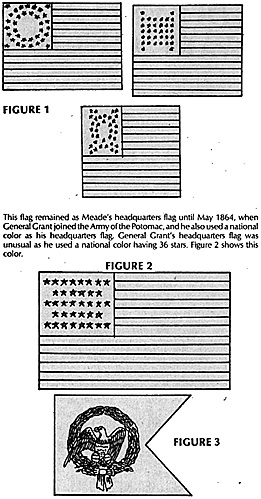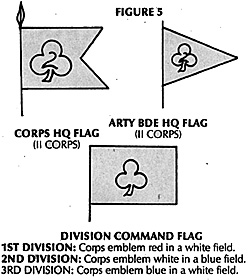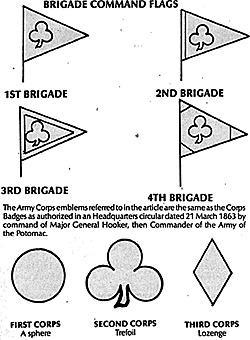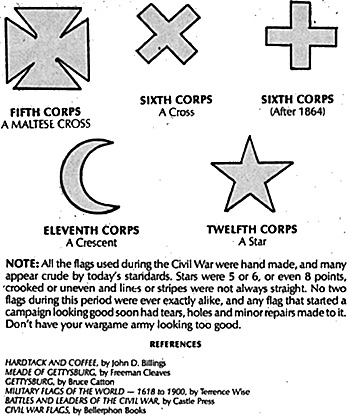
During the late unpleasantness, also known as the War Between the States, or as the American Civil War, each headquarters unit in the Army of the Potomac had its own distinctive headquarters flag.
At the time of the Gettysburg campaign, General George Meade commanded the Union Army of the Potomac.General Meade use clas his headquarters flag a simple national color, the stars and stripes. The national flag of this period had 35 stars in a blue canton, and 7 red and 6 white altemating stripes. The stars in these flags were usually white, but were frequently painted gold or silver, and as no arrangement of the stars was specified in orders, many variations existed. Figure 1 shows three variations of this
This flag remained as Meade's headquarters flag until May 1864, when General Crant joined the Army of the Potomac, and he also used a national color as his headquarters flag. General Grant's headquarters flag was unusual as he used a national color having 36 stars. Figure 2 shows this color.
During May 1864, after Grant joined the Army of the Potomac, General Meade replaced his headquarters flag with one of an unusual design. This flag was a lilac (purple) colored swallow-tailed flag with a silver wreath enclosing a gold eagle in the center. Meade did not display this flag for long though, because of all the ridicule he received, including Grant's comment "To what Caesar does this belong?". Meade soon replaced this flag with a smaller national color. Figure 3 shows this flag.
Each corps headquarters within the Army of the Potomac also had its own distinctive flag. In February 1863, General Hooker, then the Commanding General, issued orders that each corps headquarters was to be identified bya blue swallow-tailed flag having the corps number center in a white maltese cross. However, this order was never enforced and no record of these flags having ever been fielded can be found.
 Instead, each infantry corps headquarters fielded a dark blue swallowtailed flag bearing its own corps emblem in white, with the corps number centered in red. Figure 4 shows the headquarters flag for the Second Corps, which used a trefoil as a corps emblem.
Instead, each infantry corps headquarters fielded a dark blue swallowtailed flag bearing its own corps emblem in white, with the corps number centered in red. Figure 4 shows the headquarters flag for the Second Corps, which used a trefoil as a corps emblem.
All headquarters flags were usually carried on a nine foot staff topped with a spear point, carried by a color sergeant.
 In addition, each division headquarters of each corps also displayed its own flag. The division flags are rectangular in shape and the First Division flag has the corps emblem red in a white field, the Second Division has the corps emblem white in a blue field, and the Third Division has the corps emblem blue in a white field.
In addition, each division headquarters of each corps also displayed its own flag. The division flags are rectangular in shape and the First Division flag has the corps emblem red in a white field, the Second Division has the corps emblem white in a blue field, and the Third Division has the corps emblem blue in a white field.
Each brigade of each corps also flew its own headquarters flag. These flags were triangular in shape; see figure 5. The brigades of the First Division bear the corps emblem in red in a white field, and to distinguish them, the First Brigade had no other mark, while the Second Brigade had a blue band or stripe next to the staff, and the Third Brigade had a blue border around the entire flag.
The brigades of the Second Division had the corps emblem in white on a bluefield. The Second Brigade had a red band or stripe next to the staff, and the third brigade had a red border around the edge of the flag.
The brigades of the Third Division had white flags with the corps emblem in blue, and the band and border of the Second and Third Brigades in red.
 Whenever a division had a Fourth Brigade, its colors were the same as the First Brigade but with the addition of pie shaped wedges of color in the three corners.
Whenever a division had a Fourth Brigade, its colors were the same as the First Brigade but with the addition of pie shaped wedges of color in the three corners.
The Corps Artillery Brigade also had its own distinctive flag. It too was triangular in shape, but was red with the corps emblem centered in white.
The importance of these headquarters flags cannot be overemphasized. They allowed a commanding general to identify and direct major sub units on the battlefield; they allowed stragglers and soldiers lost in the confusion of battle to find their units; and in the days before wire or radio communications, they helped messengers to find headquarters and commanding generals. With the flags displayed, teamsters and wagon drivers were able to find their units for resupply of ammunition and other necessities. More importantly, these flags could inspire men to glory.

Back to Table of Contents -- Courier Vol. VIII No. 4
To Courier List of Issues
To MagWeb Master Magazine List
© Copyright 1988 by The Courier Publishing Company.
This article appears in MagWeb (Magazine Web) on the Internet World Wide Web.
Other military history articles and gaming articles are available at http://www.magweb.com